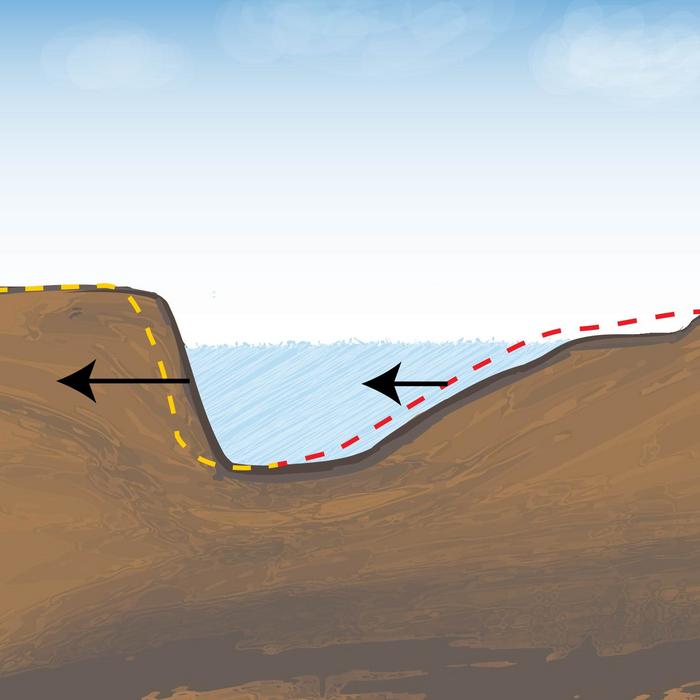Managing meandering waterways in a changing world
(Santa Barbara, Calif.) — Just as water moves through a river, rivers themselves move across the landscape. They carve valleys and canyons, create floodplains and deltas, and transport sediment from the uplands to the ocean. Credit: Matt Perko (Santa Barbara, Calif.) — Just as water moves through a river, rivers themselves move across the landscape. […]

(Santa Barbara, Calif.) — Just as water moves through a river, rivers themselves move across the landscape. They carve valleys and canyons, create floodplains and deltas, and transport sediment from the uplands to the ocean.

Credit: Matt Perko
(Santa Barbara, Calif.) — Just as water moves through a river, rivers themselves move across the landscape. They carve valleys and canyons, create floodplains and deltas, and transport sediment from the uplands to the ocean.
A new paper out of UC Santa Barbara presents an account of what drives the migration rates of meandering rivers. The two authors compiled a global dataset of these waterways, analyzing how vegetation and sediment load effect channel movement. “We find a global-scale trend between the amount of sediment that rivers carry and how quickly they’re migrating, across all variables,” said lead author Evan Greenberg, a doctoral student in the Department of Geography.
Their results, published in the journal Earth and Planetary Science Letters, contrast with previous work that emphasized the stabilizing effect of vegetation. In this paper, the researchers highlight how the activity of meandering rivers emerges from the interplay between sediment deposition and bank stabilization by vegetation. Some of the world’s most important waterways are meandering rivers, so properly understanding their behavior is crucial to managing these natural phenomena in a changing world.
Two forces, called bar push and bank pull, act on a river bend. Bar push is caused when deposition on the inside of a bend forms a sandbar, which pushes the curve outward. At the same time, erosion on the opposite bank pulls the bend even farther outward. Sediment load has a stronger effect on the former, while the stabilizing presence of vegetation has more influence on the latter.
Scientists have proposed various hypotheses as to which factor exerts a stronger influence on meander migration. “This is a pretty contentious topic and keeps going back and forth,” said senior author Vamsi Ganti, Greenberg’s advisor and an associate professor in the geography department.
To investigate these dynamics, Greenberg and Ganti collated existing measurements of river migration rates and added data from approximately 60 additional rivers. Altogether, they compiled data on 139 meandering rivers across the globe, spanning different regions, climates, sizes and vegetation regimes. The researchers modeled each river channel as a series of line segments using satellite imagery. They could then track how these segments shifted over time to measure the river’s migration.
The leading paradigm was that vegetation slows down this migration by stabilizing the outer bank against erosion. This contrasted with experimental evidence suggesting that sediment load could be an influential factor. Bank pull is stronger in unvegetated rivers, but as Greenberg and Ganti discovered, these tend to have higher sediment supply as well, making it difficult to distinguish the relative contributions of the two processes.
But Greenberg and Ganti’s analysis revealed a clear trend: Migration was faster for rivers that carried a lot of sediment relative to their size. The model also showed vegetation slowing down river migration, as suggested by previous studies. However, the effect was much more modest, with unvegetated rivers migrating four times faster than similar-sized counterparts, rather than the 10-fold increase reported by some of their colleagues. This suggests that bar push has a stronger influence on meandering rivers than bank pull.
That said, river behavior flows from the confluence of the two processes. “You can’t have one dominate the other in a meandering river,” Ganti said. “If you don’t have enough sediment supply, bank pull will outpace bar push, and you’ll end up with a braided river. And so it’s really the balance between the bar push and the bank pull that creates these stable meandering rivers.”
Dams provide a ready-made case study for investigating the contributions of these two mechanisms, since the structures trap sediment but scarcely affect vegetation. When the authors looked at the movement of three North American rivers above and below notable dams, they found that migration rates slowed downstream, where the river was starved of sediment. They could now be certain that sediment load was driving bend migration.
Greenberg is further investigating the effect dams have not just on meandering rivers, but on all the types of rivers that have floodplains. “We want to know what dams are doing to the migration of rivers,” he said.
Many of the world’s most important waterways are meandering rivers, and hundreds of millions of people live along their floodplains, Ganti said. “So knowing how rivers move is important for managing the risks that come with bank migration.
In previous papers, Ganti has documented how sea-level rise and changes in sediment supply could affect river dynamics in the future. The results paint a picture of more active, less predictable rivers, especially when combined with more extreme weather and changing land use. For instance, scientists predict that many rivers will see increased sediment supply. “More sediment means that rivers can do more stuff,” he remarked.
Ganti plans to broaden the scope of their model. While geographers and Earth scientists have historically focused on meandering rivers, the majority of the planet’s waterways are wandering, multi-threaded rivers, he said. He and Greenberg are working on quantifying river mobility in general, across the many categories of rivers. Ideally, they want to develop a model that can describe a river’s migration as it changes type along the entirety of its length, from headwater to sea.
Journal
Earth and Planetary Science Letters
Article Title
The pace of global river meandering influenced by fluvial sediment supply
Article Publication Date
15-May-2024
What's Your Reaction?

































